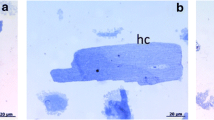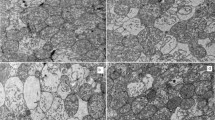Abstract
Cytosolic free Ca2+ concentration ([Ca2+]i) was measured in freshly isolated rat ventricular cardiomyocytes during substrate-free anoxia. Cardiomyocytes were loaded with fura-2 and incubated in an anoxic chamber in which a pO2 equal to 0 mmHg was realized by inclusion of Oxyrase. [Ca2+]i was measured in individual cells using digital imaging fluorescence microscopy. During anoxia, the shape of cardiomyocytes changed from a relaxed-elongated form into a rigor configuration within 15 min after the onset of anoxia. After the cells had developed the rigor state, a delayed rise in [Ca2+]i reached a stable maximal level within 45 min. The mean values for the pre-anoxic and maximal anoxic [Ca2+ i were 52±3 nM (N=42) and 2115±59 nM (N=45), respectively. The purported Na+ overload blocker R 56865, significantly reduced maximal anoxic [Ca2+]i to 553±56 nM (P<0.05), implicating a role of elevated intracellular Na+ in the anoxia-induced increase in [Ca2+]i. Veratridine (30 μM), which induces Na+ overload, increased [Ca2+]i to 787±39 nM. The compound R 56865 reduced veratridine-induced increases in [Ca2+]i to 152±38 nM. Upon reperfusion, after 45 min of anoxia, two distinct responses were observed. Most often, [Ca2+]i decreased upon reperfusion without a change in morphology or viability, while in the minority of cases, [Ca2+]i increased further followed by hypercontraction and loss of cell viability. The mean value for [Ca2+]i 10 min after reperfusion of the former group, was 752±46 nM (N=38). The cardiomyocyte cell shape could be followed by monitoring changes in the total fura-2 fluorescence (340+380 nm signal). Within 15 min after the onset of anoxia, the total fluorescence signal increased suddenly, before [Ca2+]i started to rise, coinciding with the onset of rigor contraction induced by ATP depletion.
Similar content being viewed by others

References
Allshire A, Piper HM, Cuthbertson KSR, Cobbold PH (1987) Cytosolic free Ca2+ in single rat heart cells during anoxia and reoxygenation. Biochem J 244:381–385
Bowers KC, Allshire AP, Cobbold PH (1993) Continuous measurements of cytoplasmic ATP in single cardiomyocytes during simulation of the “oxygen” paradox". Cardiovasc Res 27:1836–1939
Buja LM, Hagler HK, Willerson JT (1988) Altered calcium homeostasis in the pathogenesis of myocardial ischaemic and hypoxic injury. Cell Calcium 9:205–217
Cheung JY, Thompson IG, Bonventre JV (1982) Effects of extracellular calcium removal and anoxia on isolated rat myocytes. Am J Physiol 243:C184-C190
Cheung JY, Tillotson DL, Yelamarty RV, Scaduto RC (1989) Cytosolic free calcium concentration in individual cardiac myocytes in primary culture. Am J Physiol 356:C1120-C1130
Eisner DA, Nichols CG, O'Neill SC, Smith GL, Valdeolmillos M (1989) The effects of metabolic inhibition on intracellular calcium and pH in isolated rat ventricular cells. J Physiol (Lond) 411:393–418
Grynkiewicz G, Poenie M, Tsien RY (1985) A new generation of Ca2+ indicators with greatly improved fluorescence properties. J Biol Chem 260:3440–3450
Haigney MCP, Miyata H, Lakatta EG, Stern MD, Silverman HS (1992) Dependence of hypoxic cellular calcium loading on Na+-Ca2+ exchange. Circ Res 71:547–557
Hano O, Silverman HS, Blank PS, Mellits ED, Baumgardner R, Lakatta EG, Stern MD (1991) Nicardipine prevents calcium loading and “oxygen paradox” in anoxic single rat myocytes by a mechanism independent of calcium channel blockade. Circ Res 69:1500–1505
Haworth RA, Goknur AB, Hunter DR, Hegge JO, Berkoff HA (1987) Inhibition of calcium influx in isolated adult rat heart cells by ATP depletion. Circ Res 60:586–594
Hohl CM, Altschuld RA (1982) Response of isolated adult canine cardiac myocytes to prolonged hypoxia and reoxygenation. Am J Physiol 242:H1022-H1030
Jeremy RW, Koretsure Y, Marban E, Becker LC (1992) Relation between glycolysis and calcium homeostasis in postischemic myocardium. Circ Res 70:1180–1190
Karmazyn M, Ray M, Haist JV (1993) Comparative effects of Na+/H+ exchange inhibitors against cardiac injury produced by ischemia/reperfusion, hypoxia/reoxygenation, and the calcium paradox. J Cardiovasc Pharmacol 21:172–178
Lee JA, Allen DG (1991) Mechanisms of acute ischemic contractile failure of heart. Role of intracellular calcium. J Clin Invest 88:361–367
Lee JA, Allen DG (1992) Changes in intracellular free calcium concentration during long exposures to simulated ischemia in isolated mammalian ventricular muscle. Circ Res 71:58–69
Li Q, Hohl CM, Altschuld RA, Stokes BT (1989) Energy depletion-repletion and calcium transients in single cardiomyocytes. Am J Physiol 257:C427-C434
Luk H-N, Carmeliet E (1990) Na+-activated K+ current in cardiac cells: rectification, open probability, block and role in digitalis toxicity. Pflügers Arch 416:766–768
Marsh JD, Smith TS (1993) Calcium overload and ischemic myocardial injury. Circulation 83:709–711
Miyata H, Lakatta EG, Stern MD, Silverman HS (1992) Relation of mitochondrial and cytosolic free calcium to cardiac myocyte recovery after exposure to anoxia. Circ Res 71:605–613
Muallem S, Zhang B-X, Loessberg PA, Star RA (1992) Simultaneous recording of cell volume changes and intracellular pH or Ca2+ concentration in single osteaosarcoma cells UMR-106-01. J Biol Chem 267:17658–17664
Murphy JG, Smith TW, Marsh JD (1988) Mechanisms of reoxygenation-induced calcium overload in cultured chick embryo heart cells. Am J Physiol 254:H1133-H1141
Pauwels PJ, Van Assouw HP, Leysen JE, Janssen PAJ (1989) Ca2+-mediated neuronal death in rat brain neuronal cultures by veratridine: protection by flunarizine. Mol Pharmacol 36:525–531
Reilly RF, Shugrue CA, Lattanzi D, Biemesderfer D (1993) Immunolocalization of the Na+/Ca2+ excanger in rabbit kidney. Am J Physiol 265: F327-F332
Rose UM, Bindels RJM, Vis A, Jansen JWCM, Van Os CH (1993) The effect of L-type Ca2+ channel blockers on anoxiainduced increases in intracellular Ca2+ concentration in rabbit proximal tubule cells in primary culture. Pflügers Arch 423:378–386
Rose UM, Bindels RJM, Jansen JWCM, Van Os CH (1994) Effects of Ca2+ channel blockers, low Ca2+ medium and glycine on cell Ca2+ and injury in anoxic rabbit proximal tubules. Kidney Int (in press)
Snedecor GW, Cochran WG (1974) Statistical methods. The Iowa State University Press, Ames, Iowa
Steenbergen C, Murphy E, Levy L, London RE (1987) Elevation in cytosolic free calcium concentration early in myocardial ischemia in perfused rat heart. Circ Res 60:700–707
Steenbergen C, Murphy E, Watts JA, London RE (1990) Correlation between cytosolic free calcium, contracture, ATP, and irreversible ischemic injury in perfused rat heart. Circ Res 66:135–146
Tani M (1990) Mechanisms of Ca2+ overload in reperfused ischemic myocardium. Annu Rev Physiol 52:543–559
Tani M, Neely JR (1989) Role of intracellular Na+ in Ca2+ overload and depressed recovery of ventricular function of reperfused ischemic rat hearts. Possible involvement of H+Na+ and Na+-Ca2+ exchange. Circ Res 65:1045–1056
Tauc M, Le Maout S, Poujeol P (1990) Fluorescent videomicroscopy study of regulatory volume decrease in primary culture of rabbit proximal convoluted tubule. Biochim Biophys Acta 1052:278–284
Ver Donck L, Borgers M (1991) Myocardial protection by R 56865: a new principal based on prevention of ion channel pathology. Am J Physiol 261:H1828-H1835
Ver Donck L, Borgers M, Verdonck F (1993) Inhibition of sodium and calcium overload pathology in the myocardium: a new cytoprotective principle. Cardiovasc Res 27:349–357
Watts JA, Koch CD, LaNoue KF (1980) Effects of Ca2+ antagonists on energy metabolism: Ca2+ and heart function after ischaemia. Am J Physiol 238:H909-H916
ter Welle HF, Baartscheer A, Fiolet JWT (1988) The cytoplasmic free energy of ATP hydrolysis in isolated rod shaped rat ventricular myocytes. J Mol Cell Cardiol 20:435–441
Yu ASL, Hebert SC, Lee S-L, Brenner BM, Lytton J (1992) Identification and localization of renal Na+-Ca2+ exchanger by polymerase chain reaction. Am J Physiol 263:F680-F685
Author information
Authors and Affiliations
Rights and permissions
About this article
Cite this article
Rose, U.M., Couwenberg, P., Jansen, J.W.C.M. et al. Effects of substrate-free anoxia and veratridine on intracellular calcium concentration in isolated rat ventricular cardiomyocytes. Pflügers Arch 428, 142–149 (1994). https://doi.org/10.1007/BF00374851
Received:
Revised:
Accepted:
Issue Date:
DOI: https://doi.org/10.1007/BF00374851



